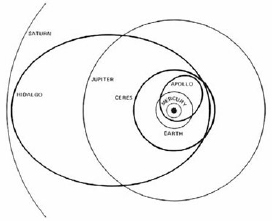1920
“Centaur” Asteroids
Walter Baade (1893–1960)
Even as the total number of discovered asteroids began to approach 1,000 in the early twentieth century, astronomers were still occasionally surprised by the discovery of new, enigmatic objects. A case in point was the discovery in 1920 of asteroid 944 by the German astronomer Walter Baade. The asteroid, which was eventually named Hidalgo after the Mexican priest and independence leader Miguel Hidalgo, turned out to have an extremely comet-like, tilted, and eccentric orbit (eccentricity of 0.66) that takes it from the inner edge of the main asteroid belt (1.95 astronomical units, or AU) out to a distance almost as far from the Sun as Saturn (9.5 AU).
In 1977, another asteroid—2060 Chiron—was discovered in a similarly comet-like orbit, moving between the distances of Saturn and Uranus. Since then, several hundred more eccentric asteroids with orbits in the zone roughly between Jupiter and Neptune have been discovered. Collectively, members of this part-asteroid, part-comet population are now called Centaurs, after the mythical part-horse, part-human creatures.
Centaurs have a range of colors, suggesting a range of compositions; indeed, telescopic spectra of some of them reveal water ice, methanol ice, and tholins, or organic residues from the solar-UV irradiation of methane or ethane ices. Many of these components are also found on comets. Three Centaurs, including Chiron, have been found to have a weak coma (a fuzzy, comet-like head), a sign of comet-like activity.

Orbit of 944 Hidalgo compared to Jupiter’s.
No Centaurs have been encountered by spacecraft, but many astronomers think that Saturn’s irregular moon Phoebe might be a captured Centaur and thus might be an excellent example of what one looks like up close. We might have to act fast to study more: because they cross the orbits of the giant planets, they have lifetimes of only a few million years before they are flung into new orbits.
SEE ALSO Main Asteroid Belt (c. 4.5 Billion BCE), Phoebe (1899), Jupiter’s Trojan Asteroids (1906), Kuiper Belt Objects (1992).
Painting by artist and planetary scientist William K. Hartmann imagining a close flyby of the Centaur asteroid 5145 Pholus. Like other Centaurs, Pholus has physical and orbital properties that make it seem like part asteroid and part comet.
